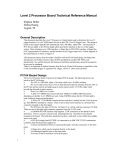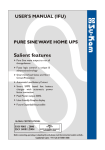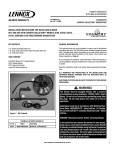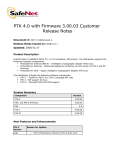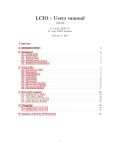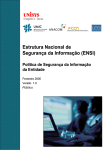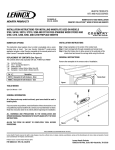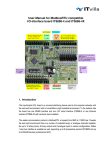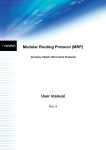Download CP505 ATSC Processor Release Notes
Transcript
CP505 ATSC Processor Release Notes Revision: 1.8.4 (4273) 2014-01-06 Overview 2 1 Overview This document contains the SW revision history for CP505. The release note is cumulative, each chapter describing changes since the previous released version. ID: cp505_relnote CP505 ATSC Processor Release Notes Rev. 1.8.4 (4273) Upgrade instructions 3 2 Upgrade instructions • Software upgrade of the device should – if possible – be done at a time when the device is not in use for critical signal transmission. • Always take a backup of the device’s current configuration before doing the upgrade (use Device Info > Save/load Configs > Save Configuration in the device’s GUI). • Have a copy of the original software file currently in use at hand, in case of a need for reverting to the last operational state. 2.1 How to upgrade • Log into the unit as admin using any web browser. Navigate to Device Info > Maintenance > Software Upgrade and click on Browse. Then upload the software image (*.out) from your file system. • After the software is loaded the unit will reboot and load the new software image. Loading the new software image takes the same amount of time as a normal reboot, which may take from 45-90 seconds. • It is possible to upload the software to the unit, and postpone the reboot operation. The old software will be used until the next reboot. This is done by ticking off the Reboot on success option on the Software Upgrade page. • If you have T-VIPS Connect, refer to the T-VIPS Connect User’s Manual on how to upgrade several units. ID: cp505_relnote CP505 ATSC Processor Release Notes Rev. 1.8.4 (4273) Release 1.8.4 Foya 4 3 Release 1.8.4 Foya 3.1 Release date 2014-01-06 Maintenance release including patches and updated GUI to comply with the Nevion theme. 3.2 Features 3.2.1 DHCP/DNS Unit now supports automatic IP address assignment by DHCP on the Ethernet interfaces. When using this function a hostname can be registered for the unit on the DNS server by the DHCP server. This makes it possible to access the units on the network by name instead of IP address. When configuring a uni-cast destination for transmitted IP streams, it is now possible to specify the destination by hostname instead of IP address. The VLAN interface configuration pages have been slightly changed to adapt to the new parameters for DHCP. 3.2.2 PSI/SI/PSIP table version numbers Added support for manually specifying the version numbers on statically played out PSI/SI/PSIP tables. Note: remark that receivers that only look at version numbers to detect changes may not work properly if you change the content of a table without also changing the version number. 3.2.3 IP Outputs • Option added to override the default SSRC ID field, separately on data and FEC streams. This was added for compatibility with another manufacturers IP inputs. • Support for transmission of 204 byte TS packets on IP. Limitation is that if 204 is to be used on IP, 204 must also be selected on ASI. You may still use 204 on ASI but 188 on IP. 3.2.4 IP Inputs • Added alarm on missing row/col FEC stream when FEC enabled. • Support for reception of 204 byte TS packets on IP. Packet length is auto-detected. ID: cp505_relnote CP505 ATSC Processor Release Notes Rev. 1.8.4 (4273) Release 1.8.4 Foya 5 3.3 GUI • Alarm description text added on each alarm for better documentation of the purpose of the alarm, without having to refer to the user’s manual. 3.4 Issues fixed 3.4.1 PMCP Dynamic PSIP EPG • A few improvements on PMCP loading of dynamic PSIP EPG. • A potential fix for reported problem on hanging PMCP service. 3.4.2 IP inputs • Fixed a problem with latency calculation when receiving IP streams with frames out of order and row FEC processing enabled. Symptom would be slowly increasing latency to be displayed. • Fixed a problem with handling of out-of-order streams when running with relatively low latencies and without FEC processing. This usage scenario could cause reporting of missing packets and disturbances on input signal. • Fixed an issue where the FEC engine would introduce errors for very specific FEC and Data receive patterns. The issue appeared if both FEC Row and FEC Column was received before a row of Data. This could happen with network equipment using different QoS settings on FEC and Data, and sometimes delaying the Data frames relative to the FEC frames by some milliseconds. This issue would typically also only be seen for FEC matrixes with a small FEC Row length. • Fixed an issue with restoring of a non-default value on the advanced page parameter “Expected PCR accuracy”. The parameter would be set to the default value after boot, and after switching regulator modes. − Fixed an issue with synching to channels with no RTP layer and TS priority bit set on PIDs in range 0x01xx. 3.4.3 TXP_post / Network • Fixed a TCP/IP network stack issue that could cause large HTTP requests to be interrupted before an answer was fully transmitted. The problem was seen on config loading requests, where processing of a received HTTP request would take several seconds before the HTTP response should be sent. In some cases a mechanism to catch hanging socket connections would take down the connection before the response was fully transmitted. • Added HTTP 411 Length Required error message on TXP post request where the HTTP parameter Content-Length is omitted. The WEB server requires this field to handle such requests efficiently. 3.5 Licensing No changes. ID: cp505_relnote CP505 ATSC Processor Release Notes Rev. 1.8.4 (4273) Release 1.6.38 Socorro 6 4 Release 1.6.38 Socorro 4.1 Release date 2013-03-18 Patch release adding support for a new feature called “Emergency Switching”. This release fixes issues listed under the “Fixes” section below. Includes new Nevion Logo after merger of the companies Nevion and T-VIPS. 4.2 Features 4.2.1 Emergency Switching Added support for the Emergency Switching feature (feature code “/ESW”). Emergency switching works with the CP210 switching panel in conjunction with one or more Nevion/T-VIPS devices. This combination enables switching of pre-loaded configurations based on push-button or relay inputs to the CP210 swiching panel. Switch positions are transferred between the CP210 and the CP505 via IP network. Please refer to the User Manual for more information on how to set up Emergency Switching. 4.2.2 VCT rebranding license key /APU A new SW license /APU is now required to perform automatic re-branding of major and minor channel numbers. 4.3 Fixes 4.3.1 PSI/SI/PSIP Editor • A few fixes on the PSI/SI/PSIP Editor included. 4.3.2 Input switching • Fixed a problem with switching to selected input when loading a configuration file with input switch in manual mode. 4.3.3 Table handling • Fixed an issue that could cause input PSIP database to be corrupted with multiple entries of VCT. The Problem was seen when two transport streams carried on a radio link were intermixed for a fraction of a second. The unit could then show inconsistent TS-IDs in the GUI. ID: cp505_relnote CP505 ATSC Processor Release Notes Rev. 1.8.4 (4273) Release 1.6.38 Socorro 7 • Fixed an issue where ETT could go missing on the output, and re-appear at the next 3hr EPG update interval. 4.3.4 PMCP Dynamic EPG • Fixed an issue that could cause PMCP FTP fetch to hang forever. The bug would be visible by checking the “Last poll” time. This value might not be updated at the configured “Update interval”. • Fixed an issue with which files that were kept in non-volatile memory in multi-file FTP fetching mode. This would affect EPG data available if the unit was re-booted with no contact with external server. 4.3.5 General • New Nevion logo added, after merging the companies T-VIPS and Nevion. • Fix to the “Generate system report” button, that would not work if default password had been changed. • Fix for editing of virtual services. The issue was affecting the display and configuration of the same input port/service on multiple output programs used to create virtual programs. ID: cp505_relnote CP505 ATSC Processor Release Notes Rev. 1.8.4 (4273) Release 1.6.24 Naramata (2012-11-28) 8 5 Release 1.6.24 Naramata (2012-11-28) This release is a software patch release fixing a number of bugs in the PSI/SI/PSIP editor. 5.1 Changes 5.1.1 Bug fixes • Fixed the problem with SI download not being available even though AFX licence (advanced functionalities) was present. • Fixed a bug in the PSIP editor. In some generated tables, the language descriptor was not generated correctly. • Improved the display/parsing for several types of PSI/SI/PSIP tables. ID: cp505_relnote CP505 ATSC Processor Release Notes Rev. 1.8.4 (4273) Release 1.6.10 Vadodara (2012-11-06) 9 6 Release 1.6.10 Vadodara (2012-11-06) This release adds one new feature to the CP505, namely the generation of EIT/ETT-tables from PMCP XML-files, as standardized in ATSC A/76. The CP505 can acquire PMCP XML-files from an HTTP-server or an FTP-server. 6.1 Changes 6.1.1 PSI/SI/PSIP Editor • The PSIE licence, enabling the PSI/SI/PSIP Editor, is now a licence separate from the advanced functionalities licence. • Added functionality to generate the default regional rating tables for US and Canada. 6.1.2 PMCP support • Requires a PMCP licence. • Enables ingest of PMCP XML-files via HTTP or FTP and generation of EIT/ETT-tables (in ATSC mode). 6.1.3 Bug fixes • Fixed a bug where (T)VCT-tables when set to ’Playout Regenerated’ were not played out correctly if the table was spanning more than one section. • Fixed a bug where additional generated descriptors were not inserted when playing out (T)VCT. • Fixed a memory leak when regenerating MGT or (T)VCT. • Several minor bugfixes in the GUI. 6.2 Licensing The following table lists the available licence options in this SW version. Table 6.1 The list of licensed features in this version Key Function ISW Input switching. Enables automatic input switching. TCON Connect control. Enables management of a device with the Connect Tool. AFX Advanced functionalities. Enables Advanced mode. PSIE PSI/SI/PSIP Editor. Enables the PSI/SI/PSIP editor. PMCP Enables EIT/ETT generation according to the PMCP standard (ATSC A/76). ID: cp505_relnote CP505 ATSC Processor Release Notes Rev. 1.8.4 (4273) Release 1.2.4 Tioga (2011-10-20) 10 7 Release 1.2.4 Tioga (2011-10-20) This release adds three new features to the CP505, namely PSI/SI/PSIP editor, input switching and dual power support. Additionally the unit has now a 6 ASI port configuration with two IP inputs and 8 IP Outputs. 7.1 Changes 7.1.1 PSI/SI/PSIP Editor • Requires Advanced functionalities licence. • Build tables from scratch or import tables from input ports, a file, the currently transmitted data or the currently stored static tables. • PSI/SI is available in DVB mode and PSIP in ATSC mode. 7.1.2 Input switching • Requires Input switching licence. • Ability to switch automatically on sync loss and critical alarms based on a prioritized input list. • Possibility to automatic fall back to main input. 7.1.3 Port configuration • A 6 ASI port configuration is now supported by the software. 2 inputs and 4 output copies. • The unit now supports 2 IP Inputs and 8 IP outputs when using the 6 ASI port configuration. 7.1.4 Bug fixes • Fixes some stability issues with the Triveni server. 7.2 Licensing The following table lists the available licence options in this SW version. ID: cp505_relnote CP505 ATSC Processor Release Notes Rev. 1.8.4 (4273) Release 1.2.4 Tioga (2011-10-20) Table 7.1 11 The list of licensed features in this version Key Function ISW Input switching. Enables automatic input switching. TCON Connect control. Enables management of a device with the Connect Tool. AFX ID: cp505_relnote Advanced functionalities. Enables Advanced mode. CP505 ATSC Processor Release Notes Rev. 1.8.4 (4273) 12 8 Release 1.0.20 (2011-06-10) This release is the first official release for CP505. 8.1 Features • Features for the two versions of the product (Version A: Network adaptation, Version B: Network adaptation and processing) • ASI, ST310, IP (in/out) • Multiple TS output copies • IP small-casting • FEC • TR 101 290 Pri 1. monitoring • Rate adaptation - add/remove null-packets (Version B) • PID and service filtering with dynamic update of PSI/SI/PSIP tables (Version B) • PID remapping (Version B) • PSI/SI/PSIP download and playout (Version B) • “Ghost PID” - add PID to a service and update signalling (Version B) • Version B can be configured to operational mode A (Version B) 8.2 Known issues No known issue at the publication date. ID: cp505_relnote CP505 ATSC Processor Release Notes Rev. 1.8.4 (4273)













